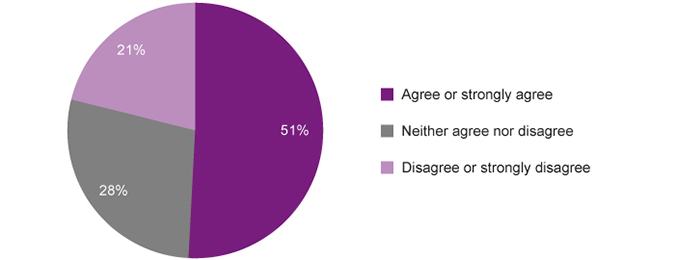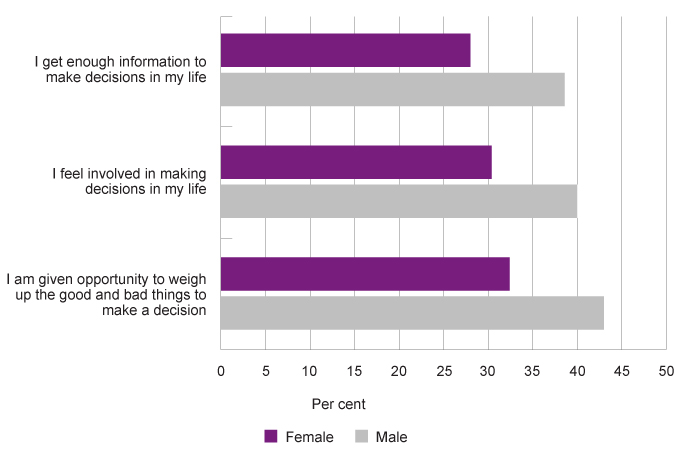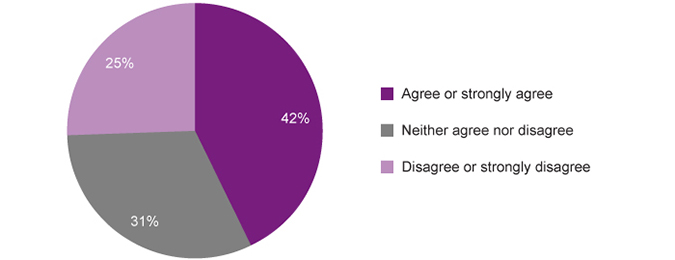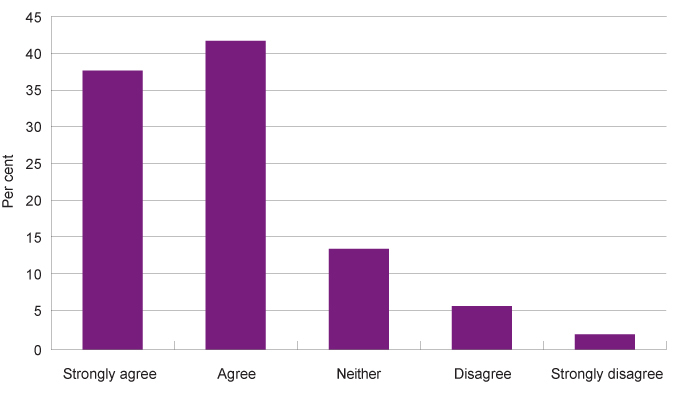Autonomy and voice

Article 12 of the United Nations Convention on the Rights of the Child states that children and young people have a right to give their opinion and be listened to by the adults around them. Giving young people a voice and encouraging them to be involved in decisions affecting them contributes to the development of self-esteem and identity. It also enables young people to learn how to develop and articulate opinions and make choices which can influence events.
Last updated June 2020
Some data is available on whether WA young people aged 12 to 17 years feel that their autonomy is supported and voice is heard.
Overview
The term ‘participation’ is often used to describe the active involvement of children and young people in being informed, expressing their views, having their views listened to and making decisions.1 For children and young people to be participants, both in their own lives and in the broader community, the acknowledgement and support of adults with whom they have contact is critical.2 When children and young people are supported to participate actively in decisions that affect their lives their wellbeing improves.3
In the Speaking Out Survey 2019, more than 80 per cent of WA Year 7 to 12 students either agreed or strongly agreed that they get enough information to make decisions in life (83.7%), that they are involved in making decisions in their life (82.6%) and that they are given opportunities to weigh up decisions (83.4%).
In the Commissioner’s 2016 School and Learning Consultation, one‑half (51.0%) of participating Year 7 to Year 12 students felt that they have a say in how things work at their school.
Proportion of Year 7 to Year 12 WA students reporting they feel like they have a say in how things work at their school

Source: Commissioner for Children and Young People WA 2018, School and Learning Consultation: Technical Report
Areas of concern
According to the findings of the 2019 Speaking Out Survey, female students are significantly less likely than male students to strongly agree that they get enough information to make decisions in their lives (28.0% of female students compared to 38.6% of male students) or are involved in making decisions in life (30.4% compared to 40.0%).
Specifically, regarding school, the Commissioner’s 2016 student survey found that one-in-five respondents disagreed with the statement they have a say in how things work at their school. Aboriginal students were more likely to disagree with this than non-Aboriginal students (29.5% compared to 20.4%).
Endnotes
- Commissioner for Children and Young People WA 2009, Participation Issues paper, Commissioner for Children and Young People WA.
- Commissioner for Children and Young People WA 2011, Speaking Out About Wellbeing: Children and Young People speak out about being acknowledged and involved in decisions, Commissioner for Children and Young People WA.
- NSW Commission for Children and Young People 2007, Ask the Children: Overview of Children’s Understandings of Well-being, NSW Commission for Children and Young People, p. 2.
Last updated June 2020
Experiencing a level of autonomy and having a voice are important developmental aspects for young people in all areas of their life including at home and at school. Feeling their independence is supported, that they are given enough information to make decisions and being given opportunities to weigh up and make decisions in life are critical for young people.
Furthermore, providing students with the opportunity to have a say in the creation of a learning environment that best suits their needs supports their engagement with school and learning, can result in more effective strategies to address safety and promotes autonomy and responsibility for learning.1
In the Commissioner’s Speaking Out Survey 2019, students in Year 7 to Year 12 were asked a series of questions about decision making. Overall, 83.7 per cent of students either agreed or strongly agreed they get enough information to make decisions in life.
Male |
Female |
Metropolitan |
Regional |
Remote |
Total |
|
Strongly agree |
38.6 |
28.0 |
32.6 |
34.4 |
39.4 |
33.2 |
Agree |
48.8 |
51.6 |
50.9 |
50.2 |
44.5 |
50.5 |
Neither |
8.3 |
15.2 |
11.7 |
10.5 |
12.4 |
11.5 |
Disagree |
3.1 |
3.9 |
3.5 |
3.9 |
3.4 |
3.5 |
Strongly disagree |
1.1 |
1.3 |
1.4 |
1.0 |
N/A |
1.3 |
Source: Commissioner for Children and Young People, Speaking Out Survey 2019 Data Tables [unpublished]
Similar results were recorded for other questions related to decision-making. A significant majority of Year 7 to Year 12 students reported they were involved in making decisions in life (82.6%) and that they are given opportunities to weigh up decisions (83.4%). Approximately five per cent of students disagreed or strongly disagreed with each of these statements.
Female students were significantly less likely than male students to strongly agree that they get enough information to make decisions in their lives (28.0% of female students compared to 38.6% of male students), are involved in making decisions in life (30.4% compared to 40.0%) or that they are given opportunities to weigh up decisions (32.4% compared to 43.0%).
Across all questions, less than one-third of female students strongly agree that they are involved in making decisions in their life and 7.4 per cent said they do not feel they are involved in making decisions in their life.
I get enough information to make decisions in my life |
I feel involved in making decisions in my life |
I am given opportunity to |
||||
Male |
Female |
Male |
Female |
Male |
Female |
|
Strongly agree |
38.6 |
28.0 |
40.0 |
30.4 |
43.0 |
32.4 |
Agree |
48.8 |
51.6 |
46.7 |
48.3 |
44.9 |
46.8 |
Neither |
8.3 |
15.2 |
9.0 |
14.0 |
8.5 |
15.9 |
Disagree |
3.1 |
3.9 |
2.8 |
4.7 |
2.1 |
3.4 |
Strongly disagree |
1.1 |
1.3 |
1.4 |
2.7 |
1.6 |
1.5 |
Source: Commissioner for Children and Young People, Speaking Out Survey 2019, Data Tables [unpublished]
Proportion of Year 7 to Year 12 students saying they strongly agree with selected statements about making decisions by gender, per cent, WA, 2019

Source: Commissioner for Children and Young People, Speaking Out Survey 2019 Data Tables [unpublished]
No significant differences were found between students in different geographic areas and between Aboriginal and non-Aboriginal students.
Specifically, in relation to school and learning, students in the Commissioner’s 2016 School and Learning Consultation indicated that when they were provided with opportunities to have a say about school and learning it:
- developed their confidence
- increased their level of responsibility and ownership of their learning outcomes, and
- created an environment that reflects their lives and identities, in which they felt valued and comfortable to learn.2
The School and Learning Consultation found that WA students who agree they have a say in how things work at their school are more likely to feel part of their school, to like school, and to say it is very important to them to be at school every day.
Narrative responses in the survey indicated that students strongly welcome and appreciate opportunities to have a say and give their input to a range of matters affecting their school and learning. Many students who say that they don’t like school or feel like they do not belong, give reasons such as, not being listened to, not being consulted or not being given the opportunity to affect change.
In the School and Learning Consultation, one-half (51.0%) of participating Year 7 to Year 12 WA students agreed with the statement that ‘students in this school have a say in how things work’. One in five Year 7 to Year 12 students disagreed with the statement.
Male |
Female |
Metropolitan |
Regional |
Non-Aboriginal |
Aboriginal |
Total |
|
Strongly agree or agree |
48.8 |
53.2 |
49.5 |
51.7 |
51.3 |
45.5 |
51.0 |
Neither agree nor disagree |
29.1 |
27.0 |
30.8 |
26.9 |
28.3 |
25.0 |
28.1 |
Disagree or strongly disagree |
22.1 |
19.8 |
19.7 |
21.4 |
20.4 |
29.5 |
20.9 |
Source: Commissioner for Children and Young People WA 2018, School and Learning Consultation: Technical Report
Female students were more likely than male students to agree with this statement (53.2% compared to 48.8%) while Aboriginal students were significantly more likely to disagree or strongly disagree with this (29.5% compared to 20.4% non-Aboriginal students).
National School Opinion Survey
In the 2016 National School Opinion Survey,3 41.8 per cent of participating Year 7 to Year 12 WA students in government schools either agreed or strongly agreed with the statement, ‘my school takes students’ opinions seriously’. Thirty-one per cent neither agreed nor disagreed, while 24.6 per cent disagreed or strongly disagreed.
National School Opinion Survey: Proportion of Year 7 to Year 12 government school students responding to the statement: ‘My school takes students’ opinions seriously’, per cent, WA, 2016

Source: National School Opinion Survey 2016, Custom report prepared by WA Department of Education for the Commissioner for Children and Young People WA [unpublished]
A larger proportion (23.0%) of Aboriginal Year 5 to Year 12 students disagreed or strongly disagreed with the statement compared to non-Aboriginal students (19.0%).
Results from both student surveys indicate that between 20 and 25 per cent of high school students feel they have no say in how things work at their school. This finding strongly suggests that schools and their communities should allow students more opportunities to have a say about matters that affect them. Within a school environment, there are many ways students can be encouraged and supported to exercise their autonomy and contribute to decision-making, including classroom management strategies, learning activities, curriculum content and school organisation.
Endnotes
- Commissioner for Children and Young People 2018, School and Learning Consultation: Technical Report, Commissioner for Children and Young People WA, p. 114.
- Commissioner for Children and Young People 2018, School and Learning Consultation: Technical Report, Commissioner for Children and Young People WA, p. 156.
- Source: Results from the National School Opinion Survey 2016, custom report prepared by WA Department of Education for Commissioner for Children and Young People WA. All WA government schools are required to administer parent, student and staff National School Opinion Surveys (NSOS) at least every two years, commencing in 2014. The Australian Curriculum Assessment and Reporting Authority (ACARA) was responsible for the development and implementation of the NSOS. The WA Department of Education and individual schools are also able to add additional questions to the survey. In WA, the first complete (although non-mandatory) implementation of the survey was conducted in government schools in 2016. The next survey was conducted in 2018 and results will be compiled when available. The data should be interpreted with caution as the survey is relatively new and there is a consequent lack of an agreed baseline for results.
Last updated June 2020
At 30 June 2019, there were 2,420 WA young people in care aged between 10 and 17 years, more than one-half of whom (53.3%) were Aboriginal.1
The National Standards for out-of-home care Standard 2 stipulates that ‘children and young people participate in decisions that have an impact on their lives’.
In WA, children and young people in care are required to have an individualised plan that details their health, education and other needs. In 2018–19, the Department of Communities reported that 86.0 per cent of children in the CEO’s care had comprehensive care planning undertaken within set timeframes.2
To meet National Standard 2, it is critical that children and young people in care are involved in the development and maintenance of their care plan. One of the key mechanisms that the Department of Communities uses to affect care planning is Viewpoint, an interactive software program. Children and young people in care aged between five and 17 years voluntarily complete the survey during the year to record their views on their care experiences, needs and worries. According to the Department of Communities 2018–19 Annual Report, 1,938 Viewpoint surveys were completed by children and young people in care (representing a maximum possible participation rate of approximately 48 per cent).3
In 2017, CREATE Foundation asked Australian children and young people in care whether they were aware of having a case plan, overall only 43.6 per cent knew about their case plan.4 Furthermore, of those who knew of their case plan, only 57.1 per cent indicated that they had been involved in its development.5
In 2018 the WA Auditor General released a report on Young People Leaving Care. The Auditor General found that ‘the extent of a young person’s participation in decision-making and planning … was not always evident even though a large majority attend their care planning meetings. Just over half (53%) of the young people had not completed the departmental tool (Viewpoint) which seeks to assist young people in communicating their needs….’6
No data is publicly available on whether young people in care in WA feel they have a say in decisions that impact their lives.
- Department of Communities 2019, Annual Report: 2018–19, WA Government, p. 26.
- Ibid, p. 151.
- It should be noted that where the same child or young person completes a survey more than once in the relevant period, all their responses are included in this statistic. In 2018–19, there were a total number of 4,038 children aged five to 17 years in care, therefore the maximum possible participation rate that year was 48 per cent. Source: Department of Communities 2019, Annual Report: 2018–19, WA Government p. 29.
- McDowall JJ 2018, Out-of-home care in Australia: Children and young people’s views after five years of National Standards, CREATE Foundation, p. 52.
- Ibid, p. 53.
- Office of the Auditor General 2018, Young People Leaving Care: report 2, August 2018–19, Office of the Auditor General Western Australia, p. 8.
Last updated June 2020
The Australian Bureau of Statistics Disability, Ageing and Carers, 2018 data collection reports that approximately 30,200 WA children and young people (9.2%) aged five to 14 years have reported disability.1,2
People with disability, including children and young people, often experience social exclusion and barriers to meaningful participation in the community.3 There are significant issues and a range of barriers that can discourage, prevent or actively exclude children and young people with disability from participating in decisions that affect their lives. For some this can be the nature of their support needs, however, more frequently it is a culture of low expectations, lack of opportunity, inaccessible processes and social and cultural barriers.4
All young people, regardless of the range of their abilities, must be seen as active and valued participants in their lives and communities, who have the right to be heard.
For data on the adjustments that schools implement to support access and participation in learning for students with disability refer to the School attendance indicator.
Speaking Out Survey 2019
In 2019, the Commissioner for Children and Young People (the Commissioner) conducted the Speaking Out Survey which sought the views of a broadly representative sample of Year 4 to Year 12 students in WA on factors influencing their wellbeing.5 This survey was conducted across mainstream schools in WA; special schools for students with disability were not included in the sample.
In this survey, Year 7 to Year 12 students were asked: Do you have any long-term disability (lasting 6 months or more) (e.g. sensory impaired hearing, visual impairment, in a wheelchair, learning difficulties)? In total, 315 (11.4%) participating Year 7 to Year 12 students answered yes to this question.
Due to the relatively small sample size, the following results for students who reported long-term disability are observational and not representative of the full population of students with disability in Years 7 to 12 in WA. Comparisons between participating students with and without disability are therefore observational and not statistically significant. Nevertheless, the results provide an indication of the views and experiences of young people with disability.
All students were asked: How much do you agree with the statement “I feel involved in making decisions in my life”. Among students with disability, 78.7 per cent agreed or strongly agreed compared to 84.5 per cent of students without disability.
Young people with disability |
Young people without disability |
|
Strongly agree |
37.4 |
36.0 |
Agree |
41.4 |
48.5 |
Neither |
13.5 |
10.4 |
Disagree |
5.8 |
3.2 |
Strongly disagree |
2.0 |
1.9 |
Source: Commissioner for Children and Young People, Speaking Out Survey 2019 Data Tables [unpublished]
Proportion of Year 7 to Year 12 students with disability saying they strongly agree, agree, disagree, strongly disagree or neither they feel involved in making decisions in their life, per cent, WA, 2019

Source: Commissioner for Children and Young People, Speaking Out Survey 2019 Data Tables [unpublished]
A slightly greater proportion of young people with disability than without strongly disagreed or disagreed with that statement (with disability: 7.8%, without disability: 5.1%).
Similar results were recorded for other questions related to decision-making.
The results from the 2019 Speaking Out Survey suggest that most young people with disability feel that they are able to express their views, have their views listened to and make decisions about their lives. However, further in-depth analysis is required to determine whether WA young people with disability feel as if they are active and valued participants in their lives, schools and communities.
Endnotes
- The ABS uses the following definition of disability: ‘In the context of health experience, the International Classification of Functioning, Disability and Health (ICFDH) defines disability as an umbrella term for impairments, activity limitations and participation restrictions… In this survey, a person has a disability if they report they have a limitation, restriction or impairment, which has lasted, or is likely to last, for at least six months and restricts everyday activities.’ Australian Bureau of Statistics 2016, Disability, Ageing and Carers, Australia, 2015, Glossary.
- Australian Bureau of Statistics 2020, Disability, Ageing and Carers, Australia, 2018: Western Australia, Table 1.1 Persons with disability, by age and sex, estimate, and Table 1.3 Persons with disability, by age and sex, proportion of persons.
- National People with Disabilities and Carer Council 2012, SHUT OUT: The Experience of People with Disabilities and their Families in Australia: National Disability Strategy Consultation Report, Commonwealth of Australia.
- Simmons C and Robinson S 2014, Strengthening Participation of Children and Young People with Disability in Advocacy, Children with Disability Australia.
- Commissioner for Children and Young People WA 2020, Speaking Out Survey: The views of WA children and young people on their wellbeing - a summary report, Commissioner for Children and Young People WA.
Last updated June 2020
Children and young people repeatedly say in consultations that they want to feel valued, respected, listened to and have their ideas taken seriously. They also want to be involved in making decisions and influencing matters that affect them and they recognise these rights as being important to their wellbeing.
Many organisations are involved in developing and delivering services for children and young people or engaging with children and young people as part of their work. These include schools, councils, police and justice organisations, medical practitioners and hospitals, and the family court.
All organisations whose work affects children and young people are encouraged to involve them in decision making. The Commissioner has published the Involving Children and Young People: Participation Guidelines for organisations that are planning to involve children and young people in their work and decision making.
The Commissioner undertakes consultations with children and young people on a wide range of topics and prepares reports and other publications, including:
- Commissioner for Children and Young People 2020, Speaking Out Survey 2019. The views of WA children and young people on their wellbeing - a summary report, Commissioner for Children and Young People WA.
- Commissioner for Children and Young People WA 2017, Speaking Out About School and Learning, The views of WA children and young people on factors that support their engagement in school and learning, Commissioner for Children and Young People WA.
- Commissioner for Children and Young People WA 2016, Children and Young People from Culturally and Linguistically Diverse Backgrounds Speak Out, Commissioner for Children and Young People WA.
- Commissioner for Children and Young People WA 2015, “Listen To Us”: Using the views of WA Aboriginal and Torres Strait Islander children and young people to improve policy and service delivery, Commissioner for Children and Young People WA.
Data gap
There is no recent and publicly available data on whether WA young people in care feel a sense of autonomy and that their voice is being heard.
For more information on children and young people's autonomy and voice refer to the following resources:
- ARACY 2013, Inclusive Education for Students with Disability: A review of the best evidence in relation to theory and practice, ARACY.
- Australian Children’s Education and Care Quality Authority 2016, Supporting Agency: Involving children in decision-making, Australian Children’s Education and Care Quality Authority.
- Children with Disability Australia (CDA) 2014, Strengthening Participation of Children and Young People with Disability in Advocacy: Issues Paper, CDA.
- Commissioner for Children and Young People WA 2017, Speaking Out About School and Learning, The views of WA children and young people on factors that support their engagement in school and learning, Commissioner for Children and Young People WA.
- Commissioner for Children and Young People WA 2018, Engaging with Aboriginal Children and Young People Toolkit, Commissioner for Children and Young People WA.
- de Róiste A et al 2012, Is school participation good for children? Associations with health and wellbeing, Health Education, Vol 112 No 2, pp. 88-104.
- McDowall, JJ 2018, Out-of-home care in Australia: Children and young people’s views after five years of National Standards, CREATE Foundation.
- G-Force (CREATE Foundation) 2015, Children and young people’s participation strategy, prepared for the Queensland Government.




